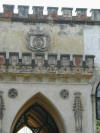Dr. František Csúzy (Čúzy),
his wife Lady Camila Csúzy born Ondrejkovič ( Ondrejkovics Sandor )
|
... der letzte davon war der gegen den Habsburgischer Aufstand des František II. ... 1489 waren hier Ján Balogh und Peter Csúzy Kastellane. ... - |
Rúbaň was settled years ago, found here slovansko-burying Avaric already 8.stor. The village is mentioned in 1268 in describing Komárňanská seats in the Fyur. Prináležala ostrihomskému archbishopric. In 1397 the village was registered as an alias FYR denominatione Fyrmonya. Between 1440-1451 the municipality has an army of John Jiskra Brandýs, attacking the mining towns around Levíc a Lučenca. The year 1505 was Mr John zemepánom Village Balogh (from cut, a relative of Sandor), a member of county Komárno Bundestag (the name of the village in the form of a tick Fywr). In 1530 it housed prominent Calvinist preachers Plechner Martin and John Pleininger. In 1538 Baloghovci sell local property Zdislava a Baltazar Seneyj, who in 1538 gave part of the property to rent Boldizsárovi Andrey and Thomas Csúzy In 1562 Rod Újfalussy (a relative of Sandor de Szlavnicza) Donations received for the entire community.
Rubáň times in the Turkish wars: The year 1552 was devastated. In 1692 the municipality received as Palatínova Donations of Merit in the battle against the Turks Imrich Akács. Later acquired the equity shares of Baron František Szluha (a relative of Sandor de Szlavnicza). The village is in 1704-1710 occurred more potýčiek between Labanc and Kuruts Rakoczi army. In 1734 the village became landlords Juraj Fekete, Imrich Csúzy and Michal Király, who received the assets of Merit in the battle against Kuruts. Assets acquired as a dowry Alexander Csere (a relative of Sandor de Szlavnicza). In 1754 the family Király priženila Hunyady family (cousin of genus Sandor de Szlavnicza), but their proportion claimed to Ocskay Julianna, her husband was Paul Balogh (relative of Sandor de Szlavnicza). Around 1778 the family became local Landlords Horváth from Disznósu. At the end of the 18th century village prehnali French soldiers, but did not cause serious damage. The village was the property of Zeman, who is changing - Tóth (a relative of the genus. Sandor de Szlavnicza), Palffy, Szalay (allied family of Hoffmann) and Ordódy (relative of the family of Sandor Szlavnicza). Skirmish between the imperial troops and insurgents have taken place in Fýrskej released in 1849. In Rubáň since 1840 was the post office, railway station and, shortly, the telegraph. In 1924, in Rubáň Land reform: land split between the local population. In 1946 began parcelácia local lordships. In 1948 the name was changed to Municipality Rubáň.
Population: the year 1869 lived in the village of 750 inhabitants, by 1900 this number increased to 1048 and increased in 1930 was 1,301 people, in 1940 their number decreased to 1,227 in 1948, even for 1205, but 1970, there lived 1,403 inhabitants.
Dubník district in Nové Zámky. The village is mentioned in 1236 under the name Khust. It was partly the property of the royal groom, who occupied the area Széki, but later lost it. In 1247 the king gave Sándor de Szemere in the current property in the village Semerovo Lot. His brother, Bertalan Gútu won, but they were childless, gave the village ostrihomskému archbishops. The family also acquired the assets of the existing municipalities Jasov and Rubáň. Castle or mansion was originally established the genus Csúzy. According to historians, kuria Csúzy was in the vicinity of today\'s Roman Catholic church. Alzbety Hungarian, which was first mentioned in 1317, but the older established, probably around 1270, when there Csúzy settled. The year 1416 is mentioned here Mihály Csúzy. After the end of the Turkish Wars Pál Csúzy wife Anna ÉRSEK around 1680 started the construction prízemného Late mansion layout shape "L". The old Gothic mansion was corrected and the time still passes hands of other owners. But the building had najväčššiu honor for Zsigmond Csúzy, whose wife was Kvassay Josephine (cousin of the family. Sandor de Szlavnicza). After the year 1780 began with the renovation and expansion of the building. Reconstruction mansion was completed. Probably connected with the death of the owner, which has built nearly identical in the mansion today Hurbanovo. He was pulled down in 1975. Between 1819-1822, the manor remained in the famous Czech scientist and historian František Palacký, who wrote in their newspapers that this was the happiest period in his life. Visitors and the world was an Austrian music composer Franz Schubert, Earl Tadeo Amade, pianist and composer of Hungarian origin Ferencz Liszt. Manor House became the home of a man in a time when there pobývala family. But significant number of visitors was much higher. After the death of Josephine Kvassay decline occurred buildings and change of owners. In 1998 completely dilapidated building purchased Komárňanské KT printing and publishing and started reconstruction of the manor house. It was restored wing of representative rooms, facing the zaskvelo in the original beauty. Under the building is a baroque arcade rolling cellar vaults with lune. And to preserve the royal vault room at the entrance hall. The most beautiful part of the manor house is the galley entrance portico to its triangular tympanum. Remarkably stone lining with keystone building entrance portal. Sculptures of lions at negotiable bay were created by residues found in the ground in the manor. It was excavated neskororenesance whole kernel mansion, but the resulting appearance was modified in a single classical style.
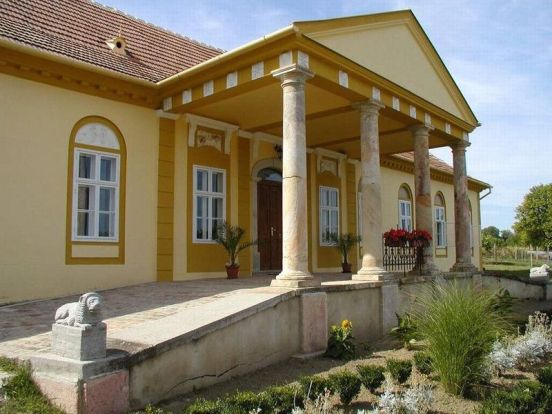
face of Palace in the village Dubník today
Painting in the House was restored by the Italian free master Gianbattistu Tiepola. Adjacent park will also be restored to the best appearance. Manor House is home to educational and cultural-historical Institute. The building is a museum of historical furniture and weapons, Lehár, Kossúth, Palacký and Pázmányi room, an exhibition of cultural heritage of Slovakia and Hall of Mirrors to organize conferences. The building, which originally not remember in any literature, and was doomed to extinction, since 2000, a cultural monument. Currently ongoing renovation work. In the neighborhood of the previous building you gave in 1780 to build Elek Hunyady (a relative of the genus Sandor de Szlavnicza) classical mansion with his wife. Below, the main street, was a Baroque castle, which he had built before 1750 Gáspár Csúzy. Further south, again in the main street, you gave Károly Szegedy classical mansion built in the early 19th century. In the neighborhood Kalvínske church was built in the early 20th century. Gyula Petrovics (a relative of the genus Sandor de Szlavnicza), the main game yeoman origin eclectic mansion.
The text was used from the booklet "Small C library vlastivedná. 235" written by Ing. Alexander Reskit. Edited by KT Publishing Ltd. Komárno, in 2003. Responsible publisher: dr. Ing. Szénássy Árpád
The author is a photo gallery of Dubník Imrich Šimonek
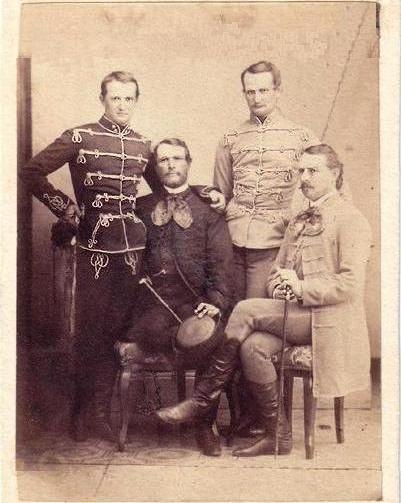
In he picture in uniform blood related of genus Sandor de Szlavnicza husband of Paula Csúzy count Otto Szirmay and his brother Viliam.
HISTORY OF VILLAGE R U M A N O V Á
In the 16th century came to the village of several new aristocratic families. We have already mentioned Farkasovcov, in addition, there is also dwelt Desseovci and Szentpéteryovci. From 18 century there were well established genera Andrássy, Eszterházy and Sandor (VSOS 1977, p. 507). For these families are physically lived only a few members of the family, mali in report section of fields and forests, respectively. mali here its Majere. Mali entitled to part of the tax in the selected municipalities. If you are wealthier, have built their manor houses and kurie. From historical documents we know that in 1543 gave John Desseó to rent their land part (portion) and a pond with a family member Szentpéteri. A few years later another left out ponds and other squire, as found that Rybnitsa economy for them economically výnostné (Gergelyi 1965). For genealogical guides know that Desseovci old Nitra nobility were known from the 80th 15th year century. Came from Janíkovce.
Genus persist until the beginning of the 17th century. Szentpétery came about from St. Peter, now it\'s part Hlohovec. In the known Rumanová were: prior to 1578 Ján, who took his wife Eufrosia Csúzy. It then had 6 children, and to Ján, Pavel, Anna (issued for relatives of Ján Beniczky related Sandor de Szlavnicza), Katarina (Stephan Ujfalussy issued to relatives of the genus Sandor, Barbara (married to Imrich Chimory) and Magdalena (married to Albert Turóczy). Línia continued with Ján. He was also the son of Ján, took the Zuzana Lencseovú. In 1656 Richard is mentioned as a widow. Richard was the son of Ján again Ján, mentions that, in the year 1656 was the only child. More fate of the family are not known (Nagy 1858, p. 293 - 294, Nagy 1858, p. 119, Nagy 1863, p. 663).
http://www.dvoryokolie.dvory.sk/dubnik.htm
In the village of Trnovec Váhom owned significant assets in the Middle Ages and especially genus Apponyi and Csúzy. Later was the main lanlord with them related and assets attached genus Hunyady. Between 1940-41 the staff of the MFA of the Slovak Republic in Rome, Emil Čúzy.
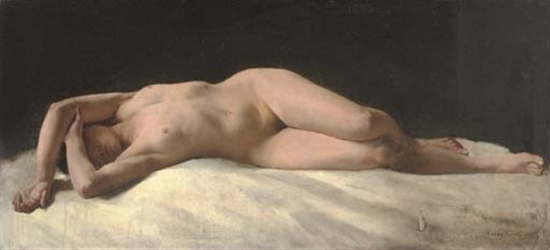
Csúzy Károly (1844-1911)
Between 1938-39 the District Chief in Ružomberok Dr. Vojtech Kállay, where he comes Dr. Karol Reindl, (his wife was sister of the District Chief Dr. Aladár Ondrejkovič.
V Hlohovci v roku 1622 župan Krištof Stanislav Thurzo založil gymnázium, ktoré v neznámom roku zaniklo. Po vymretí Thurzovcov panovník Ferdinand III daroval Hohovec Adamovi grófovi Forgách, pokrvnému príbuznému rodu Sandor de Szlavnicza. V r. 1720 odkúpil hlohovecké panstvo ďalší pokrvný príbuzný rodu Sandor de Szlavnicza Juraj gróf Erdödy za 240 000 zlotých.
Od dňa 14. novembra 1720 keď Juraj gróf Erdödy odkúpil hlohovecký majorát v ktorom mal podiel rod Sandor de Szlavnicza je kaštieľ v ich rukách. Dnešnej formy sa mu dostalo v 18. storočí, v dobe Jozefa Erdödyho. Kaštieľ bol reštaurovaný v barokovom slohu a z príležitostnej návštevy cisára Františka II. bola postavená jazdiareň a divadlo. Kaštieľ má 722 kv. siah a pojíma 84 izieb. V zámku vedľa kaplnky, v ktorej je nádherná socha P. Márie, skvosté dielo pochádzajúce zo stredoveku, sa nachádza bohatá knižnica, cenné obrazy a starožitnosti, medzi nimi i pozlatené sane M. Terézie umiestnené vo výklenku. Záhrada obkľučujúca kaštieľ zo všetkých strán, ľudom zvaná „pánska záhrada“ bola pred svetovou vojnou prístupná každému. Po prevrate, keď sa pomery zmenili, bola uzavretá. Teraz je prístup do nej len 15. augusta každého roku na takzvané „hody“ alebo „zámsku púť“. Kaštieľ je dvojposchodová biela budova, umiestnená v húšti zelených stromov a poskytujúca nádherný obraz z ďaleka.
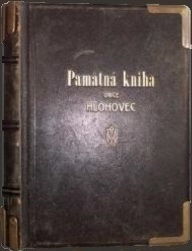
In the year 1941, the supply of drugs to the state was problematic. The "Slovak alkaloid chemical factory" was established in Hlohovec for the processing of macopus. Machines, pipelines and built-up warehouses have been installed. The plant for the plant industry has ordered makers to collect the poppies by poaching them with a 10 cm long stem. A major factor in the factory was Augustin Čúzy, the former director of the Roman Catholic People\'s School (future family Ondrejkovič and colleague of administrator teacher Stefan II. Ondrejkovič, because Kamila, sister of Gizelle, married JUDr. Frantisek Čúzy in 1945), who made great efforts to make the factory in Hlohovec. Other cities were interested in it. Súčasne bola založená i malá továreň na výrobu alpy francovky v dome na námestí ; Zdroj: Pamätná kniha obce Hlohovec od 1. júla 1933. Source: the Hlohovec commemorative book from the 1st July 1933.
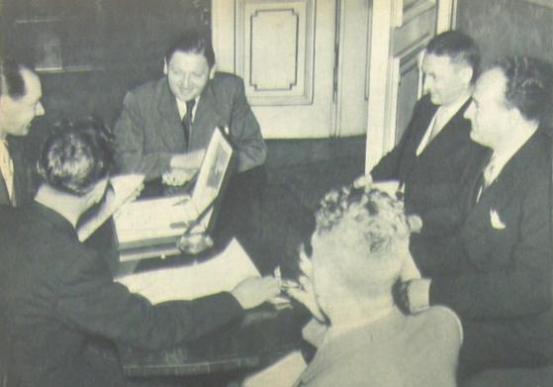
Laureáti u hlavného mešťanostu Bratislavy Dr. Stefana Ravasza. Hlavný mešťanosta Bratislavy udelil umelecké a vedecké ceny hlavného mesta Bratislavy v rámci slávnostného aktu šéfovi činohry ND Jankovi Borodáčovi, opernému spevákovi ND Štefanovi Hozovi, literárnemu historikovi univ. prof. Dr. Andrejovi Mrázovi, riaditeľovi mestských vedeckých ústavov Dr. Faustovi, sochárovi L. Majerskému, básnikovi Jánovi Kostrovi a kapelníkovi ND Tiborovi Frešovi.
Source: XII. Výročná správa Čs. štátneho vyššieho reálneho gymnázia Ľudovíta Štúra v Trenčíne za školský rok 1929-1930, str. 32, I.b 13. I.b Edita Ondrejkovičová Prečin Lehota (Trenčín) str. 32, V.b 36. Pavel Žitňan, Bánovce n./Bebr. str. 38 ; XIX. Výročná správa Čs. štátneho vyššieho reálneho gymnázia Ľudovíta Štúra v Trenčíne za školský rok 1936-1937 Menoslov abiturientov ktorí zložili skúšku dospelosti: VIII.A trieda. 2. Štefan Balažovjech, Bánovce n /Bebr., 11. František Čúzy,, Hlohovec, 16. Štefan Hegedüss, Komárno (Trenčín), str. 19 ; Aviation, third edition 1938-39 ; Lady Gizelle Kerney born Ondrejkovič ; Viliam Kamenický ;
♫ Franz Liszt - Hungarian Rhapsody No.2 ; ♫ Richard Tauber sings Serenade (Schubert) ;




_____800px-02_kastiel[1].60407_133935_23.jpg)









 back
back 
